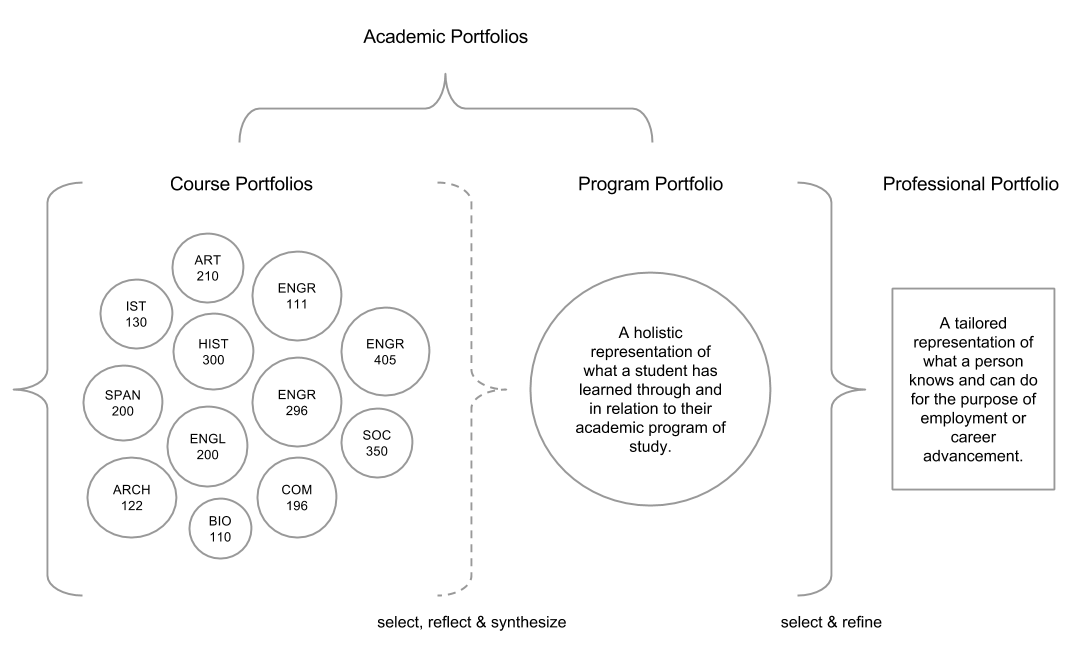Best Practices for Instructors
Purpose
Clarify the purpose of the portfolio to students.
- Why do you want your students to create a portfolio?
- How will the portfolio help your students accomplish learning objectives?
Audience
Who do you want your students to recognize as the intended audience of their portfolio? Possibilities can include one or more of the following:
- Self
- Peers
- Instructors
- Classes (e.g. peers and instructors)
- Credentialing authorities (e.g. the University, professional organizations)
- Prospective employers
- Interest groups
- General public
Recommended resource:
- Copyblogger – Helps you build a better portfolio with advice on blogging, social media, multimedia, and marketing.
Evidence
One of the benefits of web publishing is that it supports multimodal learning and multimedia expression. Evidence of learning can be shown by students in their portfolios through a variety of media, such as text, image, and video.
- What types of media are important to the field(s) of study related to your course?
- Consider providing students with opportunities to demonstrate their learning using different types of media.
Provide your students with some examples of publicly available portfolios (or websites of similar style) that they can use as models or inspiration for their own portfolio. The examples you choose should align with the purpose of the portfolio.
- For instance, if a goal of creating the portfolio is for students to replicate the communication styles of a particular profession or practice, then appropriate examples to show them would be of portfolios (or websites of similar style) determined to be outstanding within that field.
- On the other hand, if a goal of creating the portfolio is for students to have their own self-determined space, then showing them a wide variety of examples that illustrate different design options would be ideal.
Specify why you chose the examples, such as the layout or organizational structure, the colors, the font styles, the tone of language used, and the amount of content (e.g. text, images, video) on the pages.
Likewise, task students with finding some examples of publicly available portfolios (or websites of similar style) that they are interested in modeling their own portfolios after.
- Have students list the specific design qualities of the examples that they find attractive and describe how they might incorporate those qualities into their portfolio.
Recommended resources:
- Web Style Guide
- Penn State’s Media Commons
Reflection
Reflection is a key component of an academic portfolio. It allows students to build a history of thought around a particular topic and provides a mechanism for intellectual growth as it requires them to confront with conscious awareness the processes of their learning.
Posting a completed assignment to a portfolio as evidence of learning is not enough. An academic portfolio requires the author to engage in a meta-cognitive process of reflecting on what, why and how they have learned.
Assessment
Assessment is another key component of an academic portfolio. More than a grade alone, assessment in an academic portfolio calls for meaningful feedback.
Meaningful feedback provides students with opportunities for collegial discourse that can enhance their understanding of a subject and lead to new areas of inquiry and ways of thinking. It can come from a variety of sources, including instructors, peers, mentors, internship supervisors, coaches, credentialing authorities, and members of professional organizations.
Recommended resources:
Integration
Encourage your students to view portfolio creation as an intentional and iterative practice of making and presenting a comprehensive body of evidence, reflection, and assessment of their learning over time.
Consider how a course-specific portfolio might or will function in relation to requirements or recommendations of each student’s or course’s respective program of study.
Task your students with working in their portfolio from the beginning of, and throughout, the course as a continuous space for learning.
Encourage students to make connections between their portfolio and things beyond the course.
Recommend that students develop strategies for how they can organize, refine, and showcase select content from different portfolios that they may have accumulated over time.
The following graphic illustrates how different types of portfolios relate to one another.

Time
Instructors
Allow for the time it may require you to:
- Revise your course syllabus to include portfolio related assignments.
- Familiarize yourself with the same technology and processes your students will use to create their portfolios.
- Respond to requests from students for help with the processes of creating a portfolio.
- Create and maintain your own professional portfolio.
Students
Allow for the time it may require them to:
- Define the purpose of their portfolio.
- Learn how to use a web publishing platform.
- Design their portfolio.
- Upload files, such as assignments, to their portfolio.
- Keep the content and appearance of their portfolio current.
- Synthesize and reflect upon the learning experiences documented in their portfolio.
- Engage in peer review.
Platform
While there are many free and for-cost web publishing platforms available to the general public, such as Google Sites, Weebly, and Wix, we recommend using either the ePortfolio builder in Canvas, or Sites at Penn State.
Create a Portfolio
